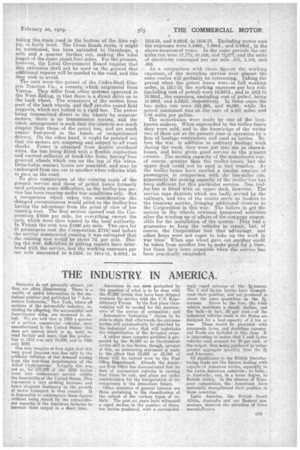THE INDUSTRY IN AMERICA.
Page 15

If you've noticed an error in this article please click here to report it so we can fix it.
Statistics do not generally attract, yet they are often illuminating. There is a wealth of useful information in the statistical number just published by "Automotive Industries," New York, where all sections of the automobile industry, including its offspring, 'the aeronautieal and farm-tractor sides, are reviewed in detail. We are told that in 1918 a.qharter of a million commercial _vehicles , were manufactured in the United States: this does not convey much to us, until we read farther and, learn that the production in 1914 was only 35,000, and in 1910
only 9500.
One may imagine at first sight that this very great increase was due only to the artificial inflation of the demand arising from the war-time requirements of the Allied Governments. Actually this was not so, for 137,00b of the' 1918 lorriei went into commercial service within the boundariee_of the United States. This represents a very striking increase, and bears eloquent testimony to the growth of motor transport in that country. It is impossible to contemplate these figures without being struck by the extraordineiry capacity of the American factories to increase their output in a short time. Americans do not seem perturbed by the question of what is to ho done with the 47,000 lorries that have been shipped overseas for service with the U.S. Expeditionary Forces. In-the first place these vehicles will be needed for the maintenance .of the armies of occupation; and " Automotive Industries" claims to be able to state that afterwards the.overseas lorries will automatically be absorbed by the industrial army that will undertake, the rehabilitation of the devasted areas. A rather more complex problem is presented by the 40,000 or so Government lorries still in the States, though, apropos of this, an interesting statement is made to the; effect that 20,000 or 25,000 of them 'will be turnedover to the Post Office Department. Already the American Post Office has demonstrated that its fleet of commercial vehicles is earning four times its cost, and plans are under consideration for the inauguration of dei
velopments in the immediate' future. •
Other statistics of general interest are those pertaining to the classification of the output of the various types of vehicle. The past six years have witnessed a rapid decline in the number of three. ton lorries produced, with a correspolid ingly rapid advance of 'the31-tonner. The 5 and 51-ton lorries have 'strengthened their position, and are produced in about the same quantities as the 31tonness. Never to the. fore, the 4-ton vehicle manifests a steady decline and the bulk—in fact, 50 per cent.—of the industrial vehicles made in the States aro designed for a load-capacity of 1 ton or less. These would be provided with pneumatic tyres, and doubtless Commercial Fords are included in this class. It is interesting to notice that 1 and 1l-tolt vehicles each account for 10 per cent, of the output, thus being produced in rather greater aggregate quantity than the 31 and 5-tonners.
'Of significance to the' British Manufacturing trade are the figures dealing with exports 'of American lorries, especially to the .Latin-American countries ; toIndia ; to Australia; and, to a lesser degree, to British Africa. In the absence of European competition the Americans have materially strengthened their position in these countri
Latin America, like British South Africa, Australia and our Eastern possessions, deserves the attention of home manufacturers.






















